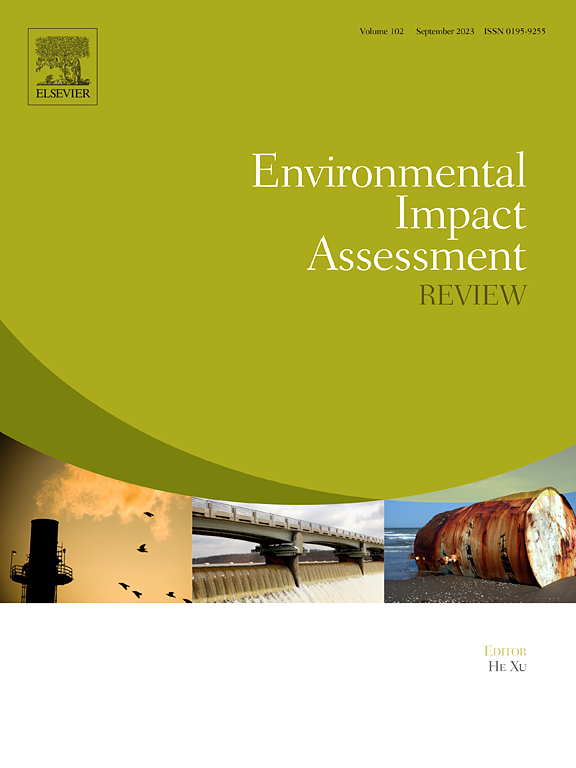The role of carbon sinks and renewable energy in the allocation of China's provincial carbon emissions allowance: From the perspectives of equity, efficiency, and continuity
IF 9.8
1区 社会学
Q1 ENVIRONMENTAL STUDIES
引用次数: 0
Abstract
Carbon sinks and renewable energy are crucial natural endowments for achieving net-zero emissions and should be integral to carbon control strategies, including carbon emissions allowance (CEA) allocation. However, the roles of these endowments in CEA allocation remain unclear. This paper presents a comprehensive allocation framework, examining 43 decision scenarios to assess how carbon sinks and renewable energy endowments influence the allocation process for China's carbon abatement target in 2030. These scenarios' equity, efficiency, and historical continuity are evaluated to reveal the influence through the Gini coefficient, EBM-DEA model, and social network analysis. Results indicate that the modified efficiency criterion scenario, where carbon sinks and renewable energy endowments are integrated with the SBM-DEA model, offers the best equity and efficiency. Under this optimal scenario, the capacity of renewable energy endowments to drive economic development and the total amount of carbon sinks directly influence provincial CEA, favoring eastern and southern provinces, which receive higher allowances than northern regions. Conversely, scenarios based directly on natural endowments are less equitable with lower efficiency scores, where the interprovincial differences in CEA are exacerbated. To avoid abrupt fluctuation in provincial development orientations, the historical continuity of each allocation scenario shall be improved. By rationally utilizing the compensatory interactions of multiple allocation criteria, policymakers can enhance allocation equity, efficiency, and continuity. This study aids policymakers in understanding the impact of natural endowments on CEA allocation and carbon emissions reductions from various perspectives.

碳汇和可再生能源在中国省级碳排放限额分配中的作用:基于公平、效率和连续性的视角
碳汇和可再生能源是实现净零排放的关键自然禀赋,应纳入碳控制战略,包括碳排放限额(CEA)分配。然而,这些捐赠在CEA分配中的作用仍不清楚。本文提出了一个综合分配框架,考察了43种决策情景,以评估碳汇和可再生能源禀赋如何影响中国2030年碳减排目标的分配过程。通过基尼系数、EBM-DEA模型和社会网络分析,对这些情景的公平性、效率和历史连续性进行了评估,揭示了影响。结果表明,将碳汇和可再生能源禀赋与SBM-DEA模型相结合的改进效率准则情景具有最佳的公平性和效率。在此最优情景下,可再生能源禀赋对经济发展的拉动能力和碳汇总量直接影响各省的碳排放当量,东部和南部省份比北部地区获得更高的碳排放配额。相反,直接基于自然禀赋的情景公平性较差,效率得分较低,省际CEA差异加剧。为了避免各省发展方向的突然波动,应提高各分配情景的历史连续性。通过合理利用多种分配标准之间的补偿作用,可以提高分配的公平性、效率和连续性。本研究有助于决策者从多个角度理解自然禀赋对经济效益分配和碳减排的影响。
本文章由计算机程序翻译,如有差异,请以英文原文为准。
求助全文
约1分钟内获得全文
求助全文
来源期刊

Environmental Impact Assessment Review
ENVIRONMENTAL STUDIES-
CiteScore
12.60
自引率
10.10%
发文量
200
审稿时长
33 days
期刊介绍:
Environmental Impact Assessment Review is an interdisciplinary journal that serves a global audience of practitioners, policymakers, and academics involved in assessing the environmental impact of policies, projects, processes, and products. The journal focuses on innovative theory and practice in environmental impact assessment (EIA). Papers are expected to present innovative ideas, be topical, and coherent. The journal emphasizes concepts, methods, techniques, approaches, and systems related to EIA theory and practice.
 求助内容:
求助内容: 应助结果提醒方式:
应助结果提醒方式:


